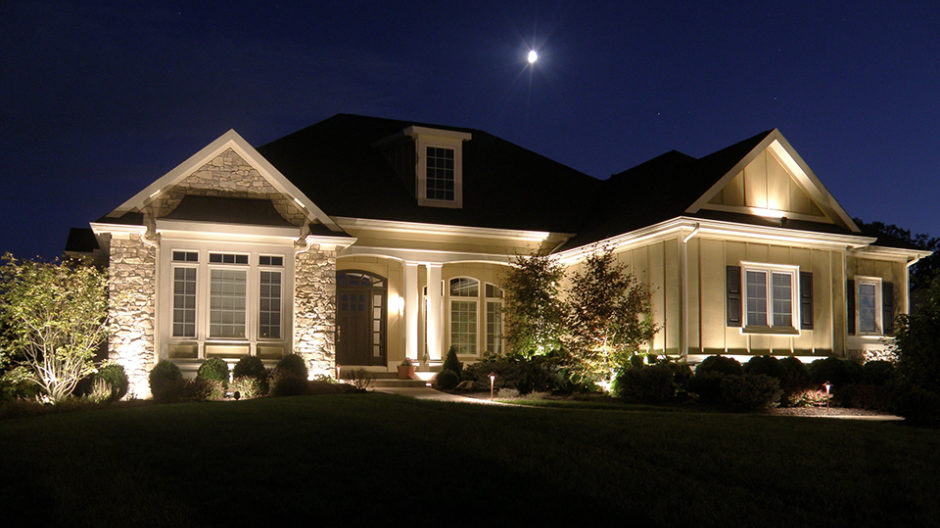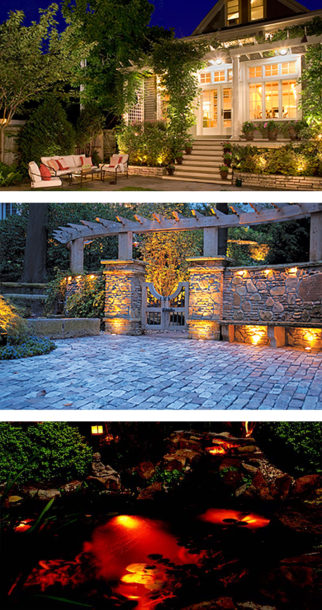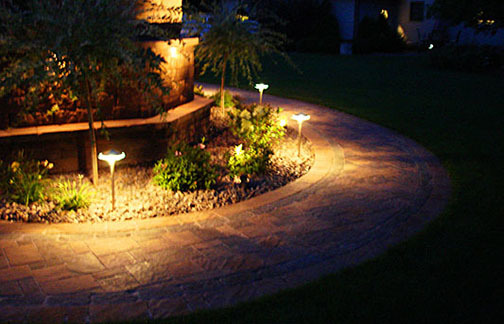The Benefits of Landscape Lighting

The Benefits of Landscape Lighting
Landscape Lighting is one of the most under-appreciated and misunderstood improvements that people can make to their homes. In fact, a 2015 ASLA survey of Landscape Architects showed that consumer demand for lighting only ranked 9th out of the top 10 landscape improvements. However, when you consider the positive impacts that landscape lighting brings to our homes, our outdoor spaces, and our quality of life it becomes evident that the benefits outweigh the costs.

figure 1 | Steps and deck lighting provides both safety and security.
The first benefits to consider is safety. This includes the illumination of surfaces and obstacles for the purposes of safely navigating walks, driveways, steps, and entryways. Providing lighting at entry points and along the walkway provide visitors with a clear direction of where they are going and how to get there. Lighting can also be used to show visitors what to avoid by highlighting potential hazards like pools, stairways, edges, and other dangers.
Security is the second benefit and perhaps the most well-known use for lighting outside of the home. Lighting makes it more difficult for unexpected or unwanted visitors, vandals, and burglars to approach your home unnoticed and helps to deter break-ins. Lighting that is activated with motion sensors can be particularly effective for security purposes. Although security is an important benefit, it needs to be carefully balanced within a lighting scheme so as not to overwhelm or minimize the other benefits.
One of the most impactful benefits for outdoor lighting is the increased functionality of outdoor spaces. Our local climate has the potential to severely limit the amount of time we spend outdoors. Any opportunity we have to expand that time and make our outdoor spaces more usable, accessible, attractive, and functional should be considered precious. Lighting can extend the use of yards, decks, patios, pools, and other outdoor spaces longer into the night, as well as, longer into the season as the daylight hours grow shorter. With the advent of new lighting control technologies, lighting can be used to create specific themes for parties and events, or intimate moods for relaxing.
The ability for light to enhance the aesthetic appearance of your home is another benefit that shouldn’t be overlooked. According to the National Association of Home Builders, 90% of home buyers rank exterior lighting as essential / desirable and one of the top three most desired outdoor features. A well designed lighting system can enhance a home’s physical appearance as well as its perceived value. The proper placement of lights can be used to accent architectural features of the home, highlight ornamental plants, and illuminate special landscape features that add to a home’s "curb appeal".
Homeowners should understand that although there are a lot of benefits to landscape lighting, there are also common mistakes that need to be avoided. The first mistake is over-illumination. This is simply too much light that is caused by having too many fixtures or using bulbs that are brighter than what is needed for a particular area or function. Light-trespass is also a common mistake made by homeowners and occurs when light spills onto a neighbor’s property or into a neighbor’s home and causes an unwanted nuisance. This is often caused by fixtures that are poorly placed or positioned and can also be a side-effect of over-illumination. Another common mistake is glare. This is the blinding effect of a bright light that causes difficulty in seeing and navigating. Glare is also caused by a poorly placed or positioned fixtures, but can also be caused by using the wrong type of fixture or bulb for a specific function. All of these common mistakes are examples of light-pollution and can be easily avoided or remedied with a properly designed lighting system that applies the right amount of light, in the right place, and for the right amount of time.
Trends in Landscape Lighting

figure 2 (top to bottom) Spot and flood lights; Well lighting; Underwater lighting enhances swimming pools, ponds, boat docks and promote safety in these areas.
The landscape light industry has made great strides in the past years and is continuing to develop new and exciting features that enhance all of the benefits.
Most landscape lighting these days are low-voltage systems. These are systems that operate on 12 volts and are easier to install, less expensive to operate, and more energy efficient in comparison to the "traditional" line voltage systems that operate on a home’s 120-volt current. The low-voltage systems cater to the DIY crowd by making transformers, controllers, fixtures and wiring that are not only safer to install but also abundantly available at local home-improvement stores and online. However, low-voltage systems do come with some downside. One issue is the need for a transformer to reduce the 120 line voltage to 12 volts. Although transformers are easy to install and offer timer and photocell control, they can be expensive and have limited capacity. Perhaps the most noticeable problem with low voltage systems is voltage-drop. This is the gradual decrease of available voltage in a wire as it extends away from the transformer. Voltage-drop can be a noticeable issue where the fixtures closest to the transformer are brightest and the fixtures farther away appear dimmer. Although this issue is inherent with any low-voltage system, there are various ways to avoid its noticeable effects. Although low-voltage fixtures have traditionally used halogen bulbs, we are now beginning to see more options for the lower watt LED option.
LED (light-emitting diode) is a technology that has been around for years but is recently making its way into more and more homes, and recently into our landscapes. These bulbs are a type of solid-state lighting that create a great amount of light while requiring less wattage and producing a small amount of heat. When LEDs where first introduced they created a cold, blue-ish light that lacked the warmth and intimacy of the standard incandescent and halogens typically used in landscape lighting fixtures. The color of light is known as its color temperature and it is measured/rated in Kelvin. Higher color temperature rating means the light will appear whiter or bluer, lower rating means the light will appear more yellow. LED technology has now evolved to the point where LED are offered in a variety of color temperatures and some LED bulbs have the ability to change colors.

figure 3 | Path and area lights.
LED technology also provides a greater range design considerations. The small size of the LED diode allows for greater design flexibility and creativity. LED’s have provided us with the opportunity to place light in areas that were problematic with incandescent and halogen. Under lighting ledges, railings, steps, and outdoor furniture are becoming popular trends while sculptural lighting applications are challenging the way we think about our outdoor environment. The pairing of LED’s with low-voltage systems allow significant advantages that include less noticeable voltage drop, longer wire runs, and more fixtures per transformer.
The growing popularity of LED’s, however, has been slowed due to their high initial cost. Although the long life and low energy consumption can offset this cost, the initial sticker-shock can be discouraging to many homeowners. Another issue to consider is the lack of heat generated by the LED bulbs. This is generally considered to be a benefit of LED technology, but may add to the maintenance of your lighting system in the winter. Most owners of traditional landscape lighting systems that use incandescent and halogen bulbs recognize the benefit of the fixtures melting the snow over and around them during the winter months, LED owners will need to manually clear the snow off of their fixtures in order to illuminate their winter-scape.
Solar powered lights have been a growing trend in outdoor lighting for many years. The minimal use of wires provides homeowners with a great amount of flexibility, easy installation, low maintenance, and low energy use. There are two general types of solar powered lighting systems available. These include independently-powered fixtures and group-powered fixtures. The independently powered fixtures have their own photocells and can be placed anywhere that sun is available but don’t operate as well in the shade. Group-powered fixtures can be placed in the shade but are limited by the length of wire that connects them to the photocell. Additionally, the group-powered photocell needs to be placed in direct sunlight. The biggest downside to solar powered lights is that they are hard to conceal in the landscape because some potion of them needs to be exposed to direct sunlight. These systems also require the use of special solar-rechargeable batteries that add an additional amount of annual maintenance. The current technology of solar power may be best described as clunky and inefficient, however, this technology has fantastic potential and will provide tremendous benefits to outdoor lighting with the development of photocells that are smaller, more efficient, and less obtrusive.
The most exciting trend in outdoor lighting is the introduction of "smart" lighting systems. This is an extension of the smart home systems that are currently growing in popularity with homeowners. The convenience of wirelessly controlling our home thermostats, lights, security systems, garage doors, and appliances through our smartphones and other devices is slowly creeping into our outdoor spaces. Current smart lighting systems allow homeowners to wirelessly control and customize the color range, color temperature, light intensity, and even program lighting themes for special events, holidays, and moods.
There are a multiple considerations when planning a landscape lighting system for your home. A properly designed landscape lighting system can ensure that homeowners maximize the benefits, add value to their home, and enhance the quality of their lifestyle.

